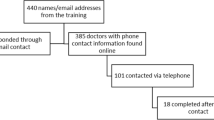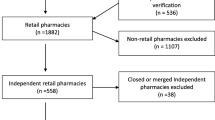Abstract
Preliminary research suggests that naloxone (Narcan), a short-acting opiate antagonist, could be provided by prescription or distribution to heroin users to reduce the likelihood of fatality from overdose. We conducted a random postal survey of 1.100 prescription-authorized health care providers in New York City to determine willingness to prescribe naloxone to patients at risk of an opiate overdose. Among 363 nurse practitioners, physicians, and physician assistants responding, 33,4% would consider prescribing naloxone, and 29.4% were unsure. This preliminary study suggests that a substantial number of New York City health care providers would prescribe naloxone for opiate overdose prevention.
Similar content being viewed by others
References
Strang J. Take-home naloxone: the next steps. Addiction. 1999;94:207.
Chamberlain JM, Klein BL. A comprehensive, review of naloxone for the emergency physician. Am J Emerg Med. 1994;12:650–660.
Strang J, Darke S, Hall S, Farrell M, Ali R, Heroin overdose: the case for take-home naloxone—editorial. BMJ. 1996;312:1435–1436.
Sporer KA. Acute heroin overdose. Ann Intern Med. 1999;130:584–590.
Seal KH, Hammond JP, Ciccarone D, Downing M, Thawley R, Edlin B. Providing naloxone to IDUs can save lives. Paper presented at: Fourth National Harm Reduction Conference; December 1, 2002; Seattle, WA.
Bigg D, Maxwell S. Enabling people to stay alive: an effective opiate overdose prevention program. Paper presented at: Fourth National Harm Reduction Conference; December, 1, 2002;Seattle, WA.
Campana S. Overdose mortality and naloxone distribution in Italy, Paper presented at: Prevention Heroin Overdose: Pragmatic Approaches; January 13–14, 2000; Seattle, WA.
Dettmer K, Saunders B, Strang J. Take home naloxone and the prevention of deaths from opiate overdose: two pilot schemes. BMJ. 2001;322:895–896.
Seal K, Downing M, Kral AH, et al. Attitudes about prescribing take-home naloxone to injection drug users for the management of heroin overdose: a survey of street-recruited injectors in the San Francisco Bay area. J Urban Health. 2003;80:290–301.
Strang J, Powis B, Best D, et al. Preventing opiate overdose fatalities with take-home naloxone: pre-launch study of possible impact and acceptability. Addiction. 1999;94:199–204.
Lenton SR, Hargreaves KM. Should we conduct a trial of distributing naloxone to heroin users for peer administration to prevent fatal overdose? Med J Aust. 2000;173:260–263.
Burris S, Norland J, Edlin B. Legal aspects of providing naloxone to heroin users in the United States. Int J Drug Policy. 2001;12:237–248.
Vilke GM, Buchanan J, Dunford JV, Chan TC. Are heroin overdose deaths related to patient release after prehospital treatment with naloxone? Prebosp Emerg Care. 1999;3:183–186.
Author information
Authors and Affiliations
Corresponding author
Rights and permissions
About this article
Cite this article
Coffin, P.O., Fuller, C., Vadnai, L. et al. Preliminary evidence of health care provider support for naloxone prescription as overdose fatality prevention strategy in New York City. J Urban Health 80, 288–290 (2003). https://doi.org/10.1093/jurban/jtg031
Issue Date:
DOI: https://doi.org/10.1093/jurban/jtg031




